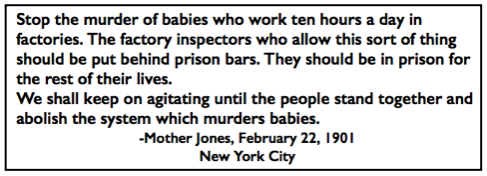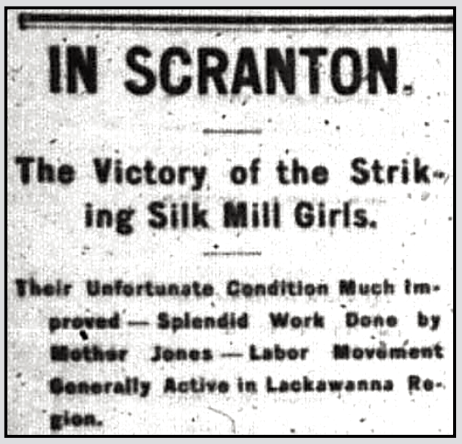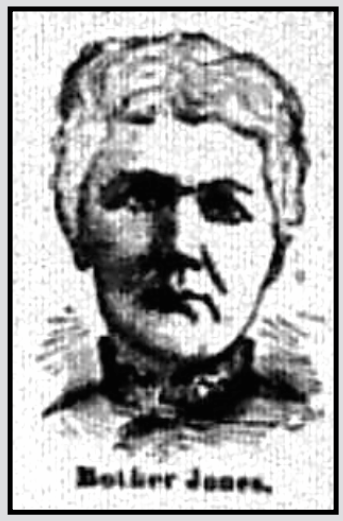 —————
—————
Hellraisers Journal – Tuesday May 7, 1901
Scranton, Pennsylvania – Silk Mill Strikers Secure Victory
From the New York Worker of May 5, 1901:
After a strike extending over three months the 5,000 silk workers of Scranton have secured a favorable settlement of their grievances, winning a complete victory, and returning to work under better conditions than they have ever experienced before. This has come about after a most stubborn fight, and only the solidarity of the strikers, under the leadership of Mother Jones gained the victory.
The strike began on January 23, when the girls at one of the mills were compelled to strike because of the treatment received from one of the forewomen. The girls had formed a union the Saturday previous and efforts were being made to disrupt it. The other mills followed the example, and within two weeks all the twelve mills in the city were closed down.
The smaller children led the way, and were the first ones to rebel. And they rebelled none too soon.The writer had the opportunity to see some of them during the past week, and he can say truthfully that anything heretofore said about their age or appearance has not been overdrawn. It is a sickening sight to see the pinched, colorless faces of these children. Their bodies are dwarfed and misshapen through the drudgery of the mill and their legs show startlingly frail and thin below the short dresses.
LABOR LAWS VIOLATED.
Some of the children are very small, so small that one wonders how they can manage to work at all. There is a state factory law prohibiting the employment of children under 13 years of age, but many of the silk workers are evidently much younger than that. It is plain the law is not enforced, although there are factory inspectors to enforce it. I should say that some of the children I saw were not more than nine or ten years old.
During the strike one of the mill owners threatened to move South to get cheaper labor, but he was answered by a Southern manufacturer, who in an interview in a local paper, said the labor of Virginia was no cheaper than that of Scranton and Wilkes Barre. Children were as cheap, and cheaper, in the Lackawanna Valley as in the South. Several of the mills already in Scranton moved from Paterson and Hoboken because the unions demanded higher wages than in Pennsylvania. Now that the unions are here, the poor abused capitalists will have to go elsewhere to find humble slaves to exploit undisturbed.
The wages before the strike in some of the mill departments ran from $2 to $3.75 a week; in others the wages fell as low as $1.25 to $1.50. For this the girls worked 10½ hours a day. At the highest this would be about six cents an hour, at the lowest two cents an hour. The average could be estimated at about four cents an hour. These are “prosperity” wages, are they not?
The average gain in wages runs from 25 to 32 cents a week. Not very much, it is true, but more than before and only the opening wedge toward getting more. Another gain is the half day on Saturday, with pay, during the four summer months, which is a concession highly prized by the strikers. Hereafter the silk will be measured, payment being had for every yard and a union girl being assigned to measure for the workers. The manufacturers also concede the right to organize, which is a most important point, and one that will be taken full advantage of. Tables will have to be provided hereafter for eating purposes, as formerly meals were eaten among the oil and grease of the machinery.
MOTHER JONES’ WORK.
This victory for the oppressed mill girls of Scranton is all the more remarkable because they had never been in a strike before, and they were practically unorganized. Two weeks after the struggle began, Mother Jones appeared on the scene and took charge of it, and it is due largely to her tact and skill in holding the girls together that they won. It is common talk that if Mother Jones had not been on the ground the mill owners and their emissaries would have broken the strikers’ ranks long ago. Whatever aid was secured for the silk workers was mainly through the instrumentality of Mother Jones, who visited Paterson, Baltimore, Philadelphia,, and other cities, and interested the unions there. The miners in the region also gave substantial aid, but the bulk of the support came from Paterson, where the silk workers’ unions gave liberally.
At a meeting held last Sunday the strike was formally declared off, and the girls decided to go to work on Tuesday. On Monday evening an entertainment was held to celebrate the victory, at which Mother Jones and the writer were the speakers. There was great enthusiasm. At 4:30 in the afternoon the children, who had been on strike paraded through the principal streets, and it was a strange spectacle to see these “babies,” as Mother Jones rightfully calls them, exhibiting their solidarity in such striking fashion. It was the babies who protested first, and they had the right to celebrate, for they were the most determined to stay out and win. But it is a dreadful thing, a horrible crime, for which every “voting king” in America should blush and feel ashamed that these helpless ones should be forced to give up their young lives to make profits for the capitalists.
TRADE UNION ACTIVITY.
In the shorttime I spent in Scranton, I learned that the victory won by the miners last fall had resulted in a great revival of unionism throughout the Lackawanna Valley. There is hardly a trade that is not now organized, or in process of organization, and there never was a time when unionism flourished so strongly as now. The latest acquisitions to the unions are the newsboys and bootblacks, who organized last Sunday. They, have started out with a grievance and that with our “Socialistic” (and slanderous) friend, the New York “Journal.” An effective boycott is being waged.
The miners’ organization is in good condition. On Sunday evening I visited Oliphant, about five miles from Scranton, where the Delaware & Hudson Railroad owns and operates most of the mines; I had a conversation with a watchman at one of the mines and made inquiries as to the conditions and wages, etc. He talked freely, while be showed me around. The men, he said, were satisfied with the way things were going in the unions, and they were glad the organization was in such good condition. Wages were higher, hours were lower and there were less grievances and more liberty. The breaker boys were benefited greatly, and the tendency of the union was to have men employed and raise the age limit, so that the boys could go to school instead of working in the breakers. All classes of employees are included in the miners’ union, and a constant agitation is going on. The mines are only running half and three-quarter time because the operators have stocked coal in preparation for a strike on April 1.
The street car men won a strike a few months ago, and since then have been working only eight hours under better conditions than ever before. One of them told me every employee on the entire system belonged to the union, and next fall they hope to adjust several existing grievances to their advantage.
A railroad man told me that the men on the Delaware, Lackawanna and Hudson were tired of the treatment they had been receiving for some time past, and very shortly they were going to have matters better adjusted. He would not commit himself as to the probability of a strike, but he said the men were determined to get more wages, shorter hours and more help on the big engines.
I was informed that there were probably 72,000 unionists in this district, and I am inclined to believe the statement. This includes miners, railroad men, street car men, mill workers, carpenters and nearly every craft. As a union town, therefore, Scranton can be said to be in the first rank.
Mother Jones will leave Scranton as soon as matters will have settled down. That she will do as much good everywhere else as she has done heretofore we shall all hope. As a hustler and fighter against the oppressors of labor she holds an unique position in the movement. Candidly, noting the effect of her motions and the manner at which she teaches the proletariat to unite; she is of more value than a hundred theorists. They talk, she acts.
WILLIAM MAILLY.
—————-
[Drawing and emphasis added.]
~~~~~~~~~~~~~~~~~~~~~~
SOURCES
Quote Mother Jones, Stt Dly Tx p3or5, Feb 23, 1901
Seattle Daily Times, Feb 23, 1901, page 3
Note: page 3 per website, actually page 5
https://www.genealogybank.com/
The Worker
(New York, New York)
-May 5, 1901, page 1
https://www.marxists.org/history/usa/pubs/the-people-the-worker/010505-worker-v11n05.pdf
IMAGE
Mother Jones, Drawing, SDH p4, Mar 9, 1901
https://www.marxists.org/history/usa/pubs/social-democratic-herald-us/010309-socdemherald-v03n38w140.pdf
See also:
Tag: Pennsylvania Silk Mill Workers Strikes of 1901
https://weneverforget.org/tag/pennsylvania-silk-mill-workers-strikes-of-1901/
The People & The Worker (1899 – 1908)
https://www.marxists.org/history/usa/pubs/the-people-the-worker/
William Mailly
https://en.wikipedia.org/wiki/William_Mailly
~~~~~~~~~~~~~~~~~~~~~~~~~~~~~~~~~~~~~
Working Girl Blues by Hazel Dickens and Alice Gerrard


